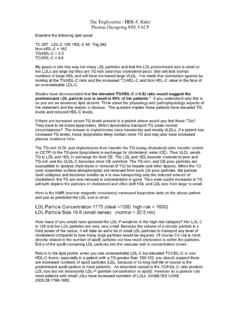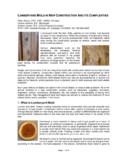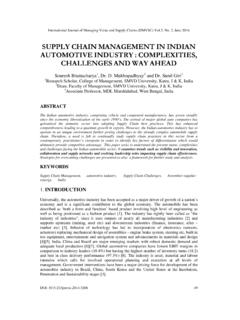Transcription of Lipoprotein (a) 2010 Lipoprotein little a (small case a as ...
1 Lipoprotein (a) 2010 Thomas Dayspring MD, FACP Lipoprotein little a (small case a as opposed to a capital A) has been confusing lipidologists for a long, long time since it was first discovered in 1963. It seems to be a risk factor in some people and not in others and race is involved. Over time the data associating Lp(a) with CV risk has gotten stronger and stronger and current opinion is until proven otherwise that Lp(a) is an independent risk factor for CHD. Lipoprotein (a), pronounced Lipoprotein " little a" is simply an LDL (a collection of core cholesteryl ester or CE and triglyceride or TG in a 4:1 ratio) with a phospholipid and free cholesterol surface enwrapped with a single molecule of apolipoprotein B 100 that has attached to it via a covalent disulfide bond a glycoprotein called apoprotein (a) which is a plasminogen-like glycoprotein.
2 Once apoprotein (a) is attached to an apoB particle the particle is called Lipoprotein (a) which is abbreviated as Lp(a). Apoprotein (a) abbreviated as apo(a) should not be confused with apoprotein A (upper case A) which is a family of very different apoproteins (apoA-I through apoA-V). In reality apo(a) can attached to any apoB particle, but of course, because of its long half life, the vast majority of circulating apoB particles are LDLs. Apo(a) can also be attached to TG-rich apoB 100 particles as they exit the liver. The Fractional Catabolic Rate of apo(a) is approximately half that of Lp(a) B-100. This newly formed Lp(a) particle releases apo(a) as the triglyceride-rich Lipoprotein portion is catabolized via receptor-mediated clearance. It is not known which receptor clears Lp(a) but it is not the LDL receptor.
3 The free apo(a) then recombines with another apoB-100 particle, most likely of triglyceride-rich Lipoprotein origin. Because about 50% of triglyceride-rich Lipoprotein is converted to LDL in the fed state, the second Lp(a) particle may survive catabolism [please see: The metabolism of apolipoproteins (a) and B-100 within plasma Lipoprotein (a) in human beings. Jennifer L. Jenner et al. Metabolism Clinical and Experimental 2005;54:361 369] NCEP ATP-III gave little impact or discussion to elevated Lp(a) levels in the final report published in 2002. They stated it may be a major risk factor but the studies at that time were inconclusive. They did note African American's can have high levels without risk and they pointed out the lab assays were far from properly developed.
4 They state: "the quantitative contribution of elevated Lp(a) to CHD risk beyond the major risk factors is uncertain." They correctly pointed out back then (and it remains true today) that there is no outcome evidence related to lowering Lp(a) with drugs. They concluded "some authorities believe that Lp(a) measurement is a useful addition to the major risk factors for identifying persons at still higher risk than revealed by those factors. According to advocates for Lp(a), the option of measurement is best reserved for persons with a strong family history of premature CHD or those with genetic causes of hypercholesterolemia, such as familial hypercholesterolemia. An elevated Lp(a) thus presents the option to raise a person s risk to a higher level. ATP III did not find strong evidence to support this approach, but accepts it as an option for selected persons.
5 " NCEP ATP-III did not discuss measuring Lp(a)-C in 2001. Lipoprotein (a) 2010 Thomas Dayspring MD, FACP Apoprotein (a) protein is made up of multiple repeated amino acid loop-like domains or motifs resembling a German or Scandinavian pretzel called kringles (K).These protein motifs or "kringles" (K) on apo(a) resemble the protein motifs on kringles IV and V that are present on the plasminogen molecule. Hence apo(a) and plasminogen have significant structural homology. Plasminogen has five different kringle domains [KI through KV or K1 through K5]. Henceforth I will use the Roman Numerals. Two of these domains are present in apoprotein (a): KIV and KV. However the KIV domain is where things become complicated. Its genetic sequence coding which controls the KIV structure is very variable among individuals.
6 Altogether, the apo(a) gene has 10 different types of KIV domains, referred to as KIV types 1 through 10. KIV types 1 and 3 through 10 are present as single copies, whereas KIV type 2 is present as multiple copies, varying in number from 3 to more than 40 copies. Those with multiple copies have the high molecular weight isoform and those with few copies will have the lower molecular weight isoform of apo(a). Apolipoprotein(a) genotype, which determines both the synthetic rate and size of the apolipoprotein(a) moiety of Lp(a), alone accounts for 90% of plasma concentrations of Lp(a). As hepatic secretion rates are lower for large apolipoprotein(a) isoforms, and as most individuals are heterozygous for two different isoforms, the smallest isoform typically but not always predominates in plasma.
7 It is for this reason Lp(a)-P [or Lp(a),particle count] does not always correlate with Lp(a) mass measurements. The heterogeneity of Lp(a), particularly with respect to apo(a) isoform size, has posed significant challenges for measurement of Lp(a) in clinical samples. Virtually all of the commercially available Lp(a) assays display an isoform size dependent bias. Assays insensitive to isoform size are not yet widely available. So let's closely examine the KIV domain on apo(a): KIV consists of distinct kringle types called 1 to 10 (KIV-1 through KIV-10). Kringle IV types 1-3 and 5-10 (KIV 1-3 and KIV 5-10) only exist in one copy. No inter-individual differences exist. KIV-2 type 2 (kringle IV type 2) has a genetically determined variable structure. KIV-2 can exist from 2 to > 40 copies of kb repeats which results in the large number of different sized isoforms of apolipoprotein(a).
8 Obviously a person having KIV-2 containing 2 or 3 repeats will have a smaller, lower molecular weight apo(a) than a person having a larger, higher molecular weight KIV-2 with 40 or more repeats. In other words, some folks have just a few copies of the KIV-2 and the next patient might have several. Thus with respect to apo(a) makeup, molecular weight and size, the most clinically important of the apo(a) polymorphisms is the KIV-2 size polymorphism. Plasma levels of Lipoprotein (a) vary greatly among individuals and are determined by the KIV polymorphisms that are present. Simply put, apoprotein (a) has a variable number of genetically determined repeats of a protein domain, kringle IV (specifically KIV-2). There are different apo(a) isoforms that account for a range of Lp(a) molecular weights (from 280 to 800 kDa).
9 The MW of the apo(a) isoform rises in proportion to the KIV-2 repeats. Thus the KIV-2 size (how many repeats or the copy number variability) polymorphism is the reason why there are different apo(a) or Lp(a) isoforms (small and large). Patients with the smaller isoforms have less KIV-2 repeats (< 22) than the larger isoforms (> 22). The number of KIV-2 repeats correlates inversely with plasma levels of Lipoprotein (a); small apolipoprotein(a) Lipoprotein (a) 2010 Thomas Dayspring MD, FACP isoforms associate with high Lipoprotein (a) plasma concentrations, and vice versa. Why is that? It seems the liver is much better at secreting the smaller apo(a) isoforms than the larger ones. The molecular weight of the apolipoprotein (a) molecule depends on how many kringle repeats are present.
10 The less the number of KIV-2 repeats, the lower the MW and the higher the hepatic secretion rate. So paradoxically, even though small isoforms have a lower molecular weight than the larger isoforms (which have more KIV-2 repeats), serum levels of apo(a) mass of Lp(a) will usually be higher patients with the smaller, lower molecular weight isoforms compared to the larger and higher molecular weight isoforms. The small, low molecular weight isoforms of apo(a) or Lp(a) are in epidemiological trials associated with more CV risk and considered more atherogenic than the larger high molecular weight isoforms. If a patient does secrete too many larger higher MW isoforms, Lp(a) mass will be high but CV risk may be lower than that suggested by the apo(a) mass measurement.
















